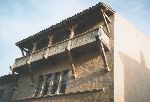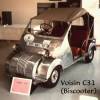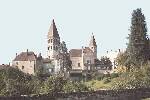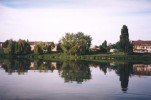Visit Tournus
Museums
The Hôtel-Dieu - Greuze Museum
The Hôtel-Dieu (charity hospital) is opened since July 1st, 1999 as a museum of the hospital life. It now accommodates the Greuze museum.
The Museum is opened from the last week-end of March to the 1st one of November, from 10 AM to 6 PM every day except on Tuesdays.
Groups may visit the Museum all the year long on appointment.
 A very nice house built in the Middle Ages homes the entrance of the Museum. It was partly rebuilt in the last years.
A very nice house built in the Middle Ages homes the entrance of the Museum. It was partly rebuilt in the last years.
The Hôtel-Dieu is a high quality estate built in the XVIIth and XVIIIth century. One will notice the ceiling painting in the chemistry and the furniture of this room (a superb collection of earthenware from Nevers shown in a wooden piece of furniture decorated with small columns and gilt decoration) and the furniture of the patients room (closed beds).
 The new Greuze Museum now stands in the Hôtel-Dieu. This transfer allows better bringing out the collections in more spacious rooms where moving among the shelves is easier.
The new Greuze Museum now stands in the Hôtel-Dieu. This transfer allows better bringing out the collections in more spacious rooms where moving among the shelves is easier.
Rare and highly interesting archaeological parts are kept in this museum: one will notice a Gallo-Roman ophthalmologist kit found in the bed of the river Saône.
Quite obviously, works by the local painter and engraver J.-B. Greuze, (1725-1805) hold an important place in the collections: 6 original paintings and many drawings are shown here. The number of his works shown in the world's main museums such as the Louvre and the British Museum confirms the importance of this artist.
Connoisseurs don't need any other reason for coming to Tournus than seeing Greuze's works.
The Burgundian Museum (Musée Bourguignon)
Standing in a house bequeathed by the literary critic Albert Thibaudet, this museum is officially named Musée Perrin de Puycousin (the man who bequeathed this museum's collections). It is infortunately closed since several years waiting for an important maintenance job on the building and the collections.
It showed a beautiful collection of traditional dressings of the surroundings of Tournus and furniture, vineyard tools, country housing... were shown in an interesting way through reconstruction of working and living places.
A project for a Gabriel Voisin museum
 The famous planes and cars builder is well know by many people in Tournus: living in the close village Ozenay, he often drive to Tournus in one of his last cars, the Biscooter, real ancestor of our modern microcars (in France, drivers don't need a driving licence for these).
The famous planes and cars builder is well know by many people in Tournus: living in the close village Ozenay, he often drive to Tournus in one of his last cars, the Biscooter, real ancestor of our modern microcars (in France, drivers don't need a driving licence for these).
The association of the Friends of the Gabriel Voisin museum is now looking for a place to install a museum dedicated to this tireless inventor.
At this time, the secondary school and technical college of Tournus is named Lycée Gabriel Voisin while the aerodrome of Tournus-Cuisery is dedicated to Gabriel and Charles Voisin (his brother who is another pioneer of aviation).
Architecture
The site of the abbey
 Saint Philibert abbey and its cloister, the abbey's buildings (chapter room, cellar, refectory, abbot's house...) draw about 500,000 visitors each year.
Saint Philibert abbey and its cloister, the abbey's buildings (chapter room, cellar, refectory, abbot's house...) draw about 500,000 visitors each year.
Several towers of the ancient ramparts of the abbey are still standing among houses around the abbey. Some of them, which are round, were built in the Middle Age; others, octagonal, were more recently built (XVIIth c.).
Since more than 1,000 years, the history of this site is closely tied to Tournus history.
The magnificent architectural estate is a living area, not only a marvellous part of our history fixed in the stone. Houses around the place are inhabited. The cellar and the refectory are used all the year long for concerts, conferences, exhibitions. The municipal library stands in one of the abbey's houses. The abbey's church, always used for mass, is also used for concerts of religious and even secular music. The organ, which was built in 1629, is magnificent and it sounds marvellously since its recent reconstruction.
Romanesque houses
Numerous, spread out in the centre town and mainly along the commercial axis (Doctor Privey street, Republic street and D. Mathivet street), they are witnesses of the civil architecture in medieval times.
The logis de la tête noire (Black Head House):
This is one of the most ancient and beautiful houses in Tournus. Standing Place Carnot, it has been the Tourist Office for several years.
Mansions
Of medieval origins or more recent (until the XVIIIth c.), they are spread along the commercial axis (Doctor Privey street and Republic street). It is necessary to know how to enter a corridor, an inside courtyard... but they are private properties that must be respected.
Roman vestiges
Some can be seen in the walls of the "Bar de l'Esplanade", in the south end of the Désiré Mathivet street. The Roman castrum (fortified village) in the south of the current town.
Saint Madeleine
This church was the one of the southern quarter built above the Roman castrum. The XIIth c. portal and the doors are to be pointed out.
The Law courts
It was built in the XVIIIth century. It's a part of the additional inventory of the French historic monuments. The commercial court of Tournus was sitting here until the beginning of the 1990's. Nowadays, the Law courts accommodate the registered office of many local associations. These may have working sessions or public meetings in some rooms while some other rooms are used by the Music School. Two very beautiful rooms at the ground floor (ancient jails) are often used for public meetings or exhibitions.
The Town hall
It was built in the XVIIIth century by the Burgundian architect Emiland GAUTHEY. A painted sundial adorns the south wall of the building.
The Saint Laurent Chapel
In the north of the town, of high simplicity, this is a noticeable monument with its walls built like fish scale. This way of assembling the stones is the sign that it was probably built a long time before the Abbey. The inside, although very ruined, still shows traces of medieval wall frescoes.
Nature and landscape:
The ornamental forest La Garenne
This forest, which was planted in the beginning of the century, counts many black pines. However, a huge effort is being realised to diversify the species. The forest now counts many different species of broad-leaved trees. A health course and a picnic area make it an attractive place for Tournusians as well as tourists.
The Saône banks
They are pleasant places to walk or ride along the ancient towing ways that have been transformed in a convenient pedestrian and cycling route. Many aquatic birds such as herons or swans live on the riverbanks. It is a real paradise for fishermen who can practice angling, casting and so on. Although some specimens of catfishes (in French "silure") are worth the first page of newspapers (some are more than 2 m long!), enjoying fried whitebait is still possible.
The forest of Plottes
This forest was planted for production purposes with pines and broad-leaved trees (and among these an important part of oaks). One will notice a sycomore (which is a specie of maple), which is higher than all other trees in this forest. Wide lanes through this forest allow walking from Tournus to Plottes almost without walking on asphalt.
The chalky grass of Mount Crâ
It is classified as Natural Area of Faunistic and Floristic Interest (Zone Naturelle d'Intérêt Faunistique et Floristique). Many animal species (birds, insects) and vegetable species (orchids) usually living in Mediterranean areas also live in our northern area. Be careful with these rare and protected species! Their presence here is due to the climate and the chalky subsoil, which help the arable layer staying relatively dry and warm.
The "cadoles" (say "cadol")
These small round houses entirely built in dry stones (i.e. without cement), are still visible when rambling among the vineyards. Some of them can be easily reached in the place named Roy Guillaume. Many cadoles have been reconstructed since 1998 in order to preserve this intersting patrimonial fund.
Not far from Tournus:
- Many environment specialists visit the nature reserve of the village La Truchère each year. Paradise of ornithologists, it has a diversified biotope: wet grass, forest, sandy soils, peat bogs alternate happily.
- The E.D.E.N. Centre (Education Discovery Environment Nature) at Cuisery, open since the 2nd quarter 98, allows visitors discovering Nature and its local marvels. But the E.D.E.N. Centre's first purpose is receiving school for several days in order to deliver them theoretical knowledge inside and practical knowledge in the surroundings.
